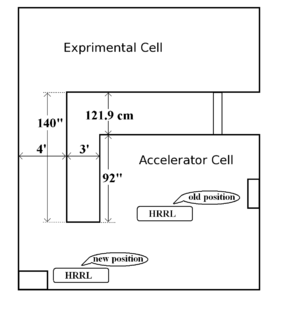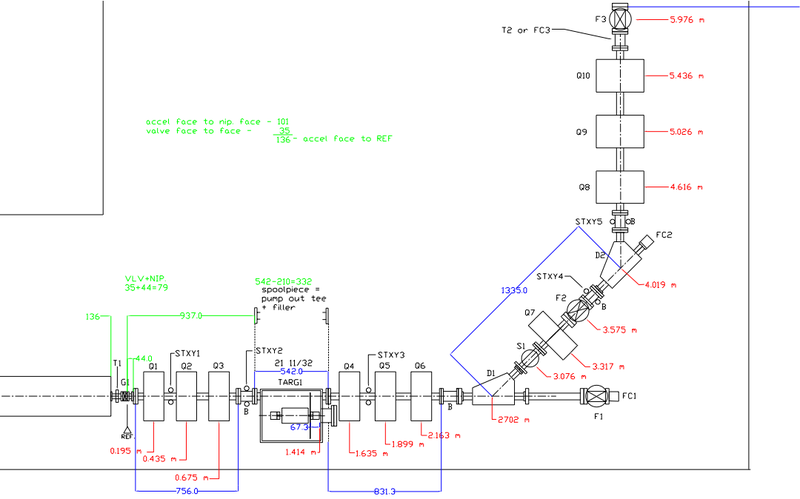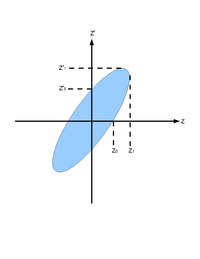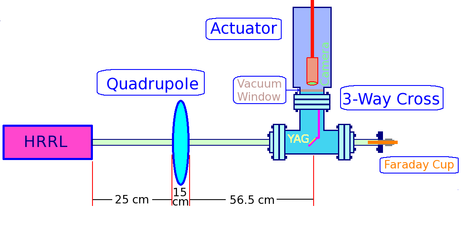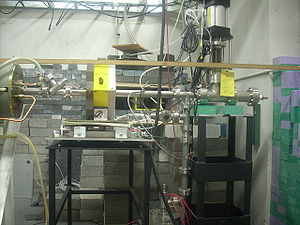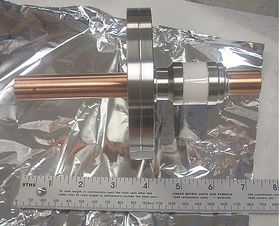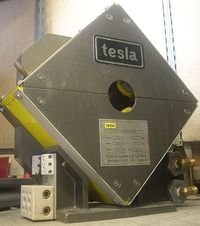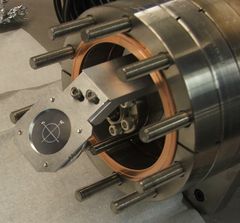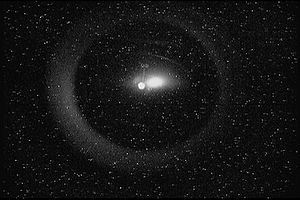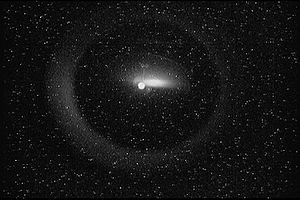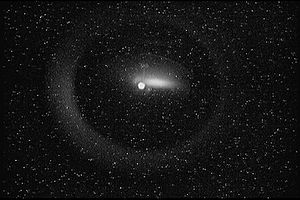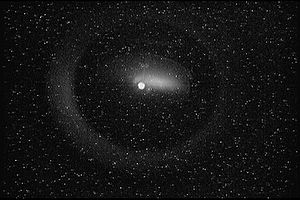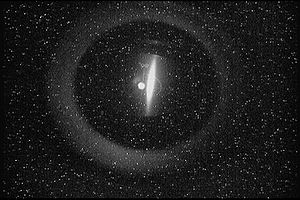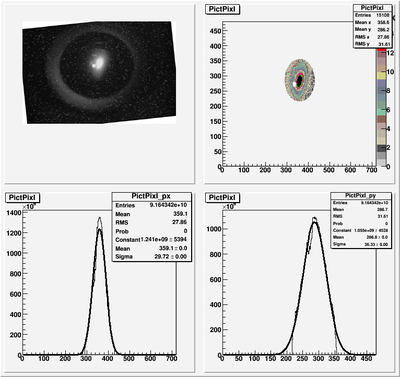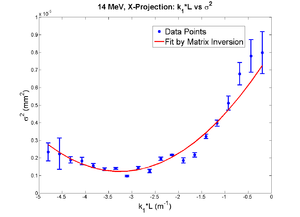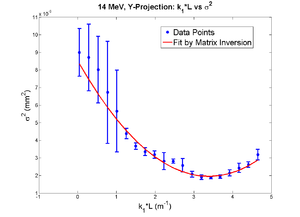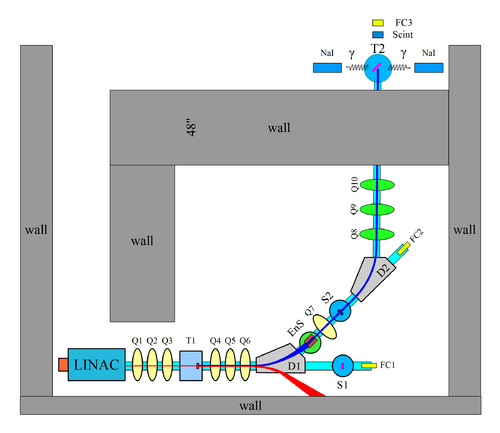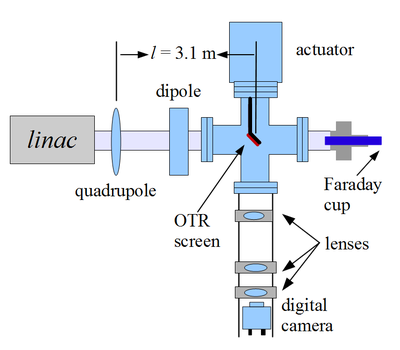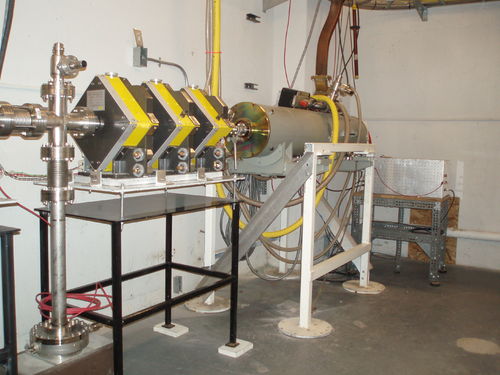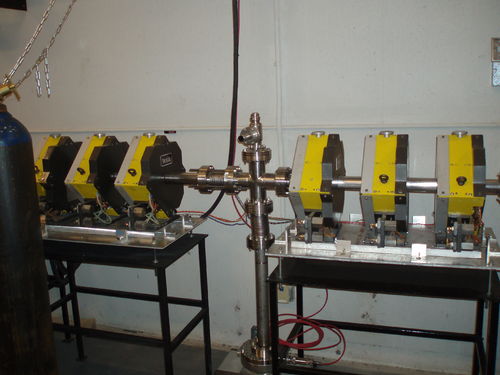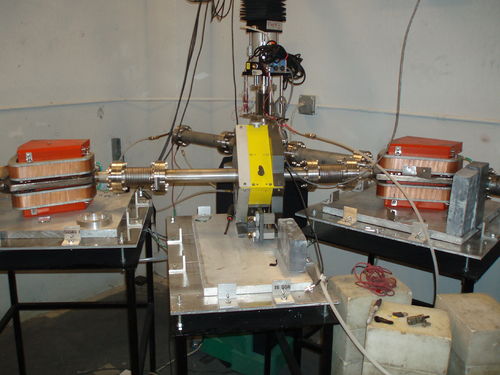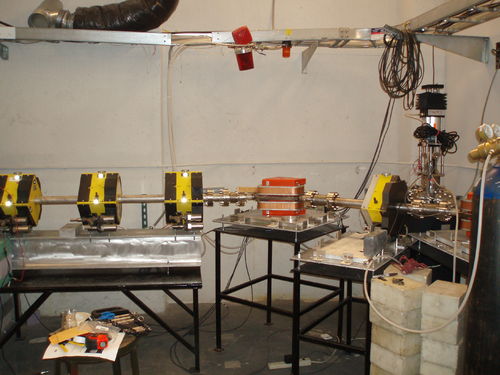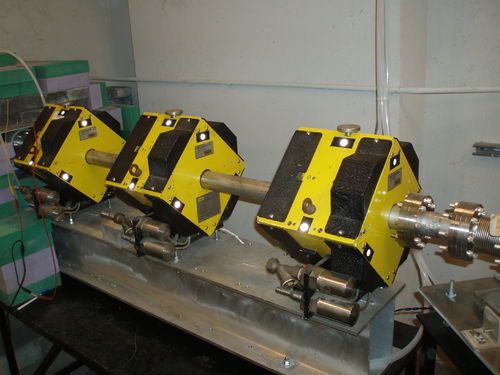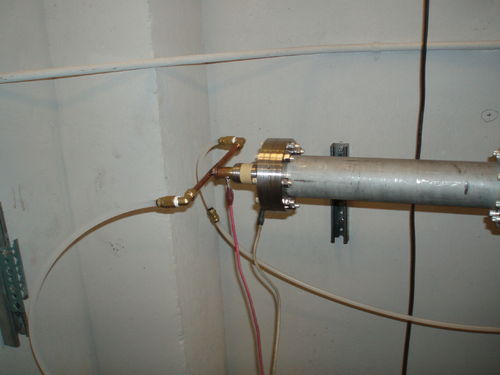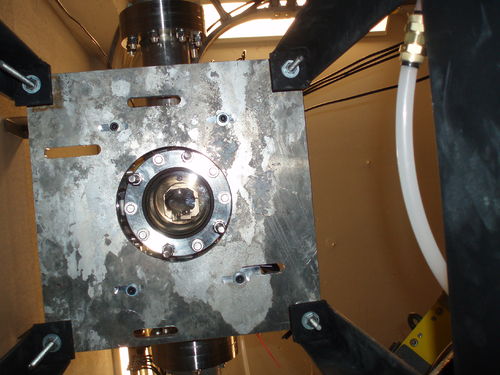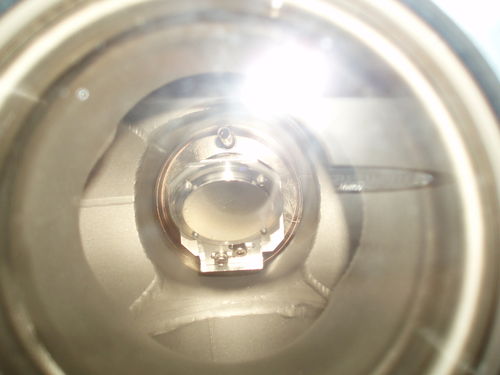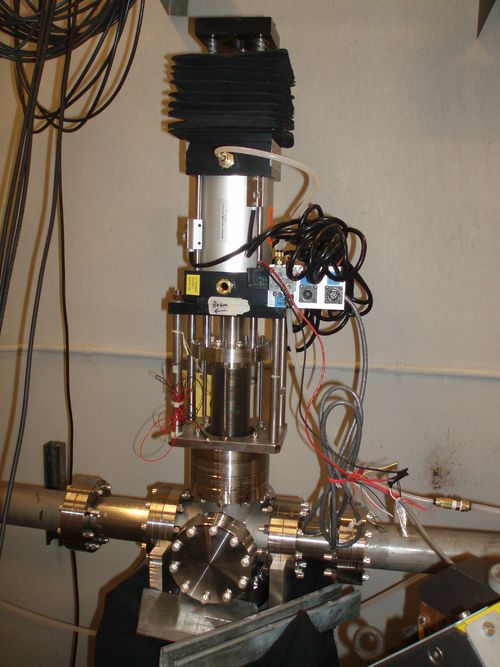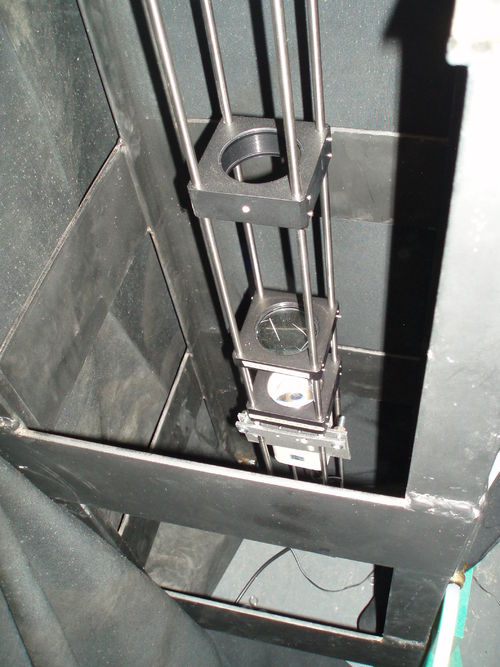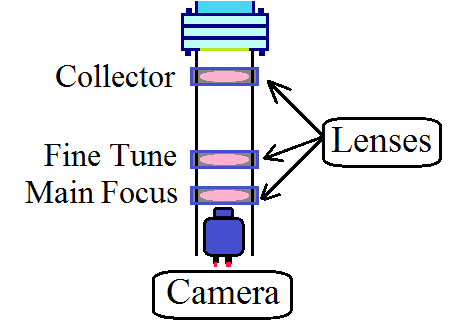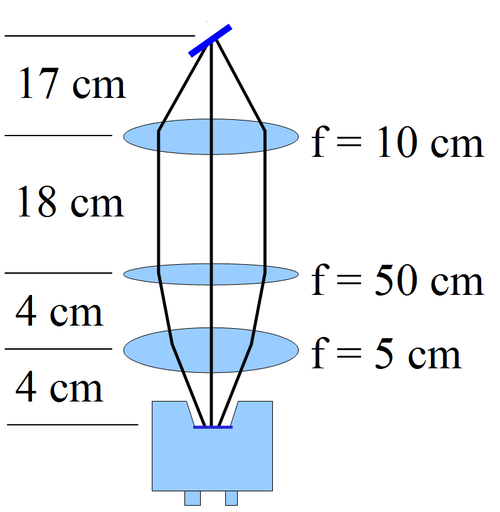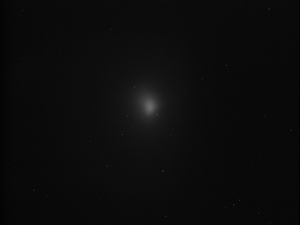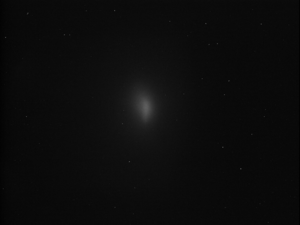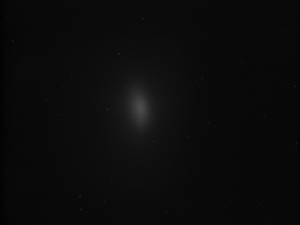Sadiq Proposal Defense Jan 2nd 2012
Abstract
We are constructing a achromatic positron source in the Beam Lab of Department of Physics at Idaho State University. We have studied the radiation level after moving the cavity to new location with GEANT4 simulation and experiment. Our conclusion is it was safe to do so. We Constructed new beamline, performed emittance measurements, and we calculated emittance and twiss parameters. We acquired some NaI crystals from Idaho Accelerator Center (IAC). We built our own PMT bases for them by modifying one the design one of the model from Saint-Gobain crystals & detectors ltd. NaI detectors tested and worked properly. A tungsten target will be placed in the space between 1st and 2nd triplet. The tungsten target will be placed inside a big chamber. To do emittance test with precise energy scan, the dipole magnet was remapped. This will also improve our emittance measurement. We are expecting to collect positrons and transport them down the second tungsten target at the end of the 90 degree beamline. By doing these, 511 keV photons will be created and we want to detect them by our NaI detectors.
Introduction
I propose to measure the efficiency of producing positrons using the High Repetition Rate Linac (HRRL) S-band electron linear accelerator. HRRL cavity is located at the Beam Lab of the Physics Department, at Idaho State University (ISU).
HRRL has max beam energy of 16 MeV, max peak current of 80 mA, max repetition rate of 1 kHz, and max pulse length of 250 ns (FWHM).
The HRRL facility is divided into two parts by a L-shaped cement wall. The accelerator cell houses the linac and magntic elements needed to transport electrons. The experimental cell is located in an adjacent room to the accelerator cell. Previously cavity was located at the center of the accelerator cell, as shown in figure below. To adapt positron project, it was relocated to new position, as shown in same figure.
Original HRRL beamline was designed by G. Stancari. Based on this designed, it was improved by Dr. Y. Kim, and was finalized by John Ellis. Design is shown on the following figure.
The beam parts were listed in the following table given by John Ellis.
| Label | Beam Line Element | Z location from Gate Valve center of element | Dimensions of Element |
| T1 | Torroid 1 | -0.05 m | |
| G1 | Fast Gate Valve | 0.000 m | |
| STXY1 | X-Y steerers 1 | want to locate before Q1! | |
| Q1 | First Quad | 0.195 m | (was moved from 0.175 to 0.195) |
| Q2 | Second Quad | 0.435 m | (was moved from 0.425 to 0.435) (24 cm to Q1) |
| Q3 | Third Quad | 0.675 m | (24 cm to Q2) |
| STXY2 | X-Y steerers 2 | ||
| Targ1 | positron production target | 1.175 m | |
| Q4 | Fourth Quad | 1.635 m | (was 1.4 now 1.635) |
| Q5 | Fifth Quad | 1.659 m | was 1.650 drawing has 1.899 we want it at 1.659 (want distance to Q4 to be 24 cm) |
| Q6 | Sixth Quad | 1.683 | was at 1.8 drawing has it at 2.163 we want it at 1.683 (want distance to Q5 to be 24 cm) |
| STXY3 | X-Y steerers 3 | ||
| F1 | OTR Flag | ||
| FC1 | Faraday Cup 1 | ||
| D1 | First Kiwi Dipole | 2.702 m | was 2.525 now it is 2.702 |
| S1 | Energy Slits | 3.076 m | was 2.851 now at 3.076 |
| STXY4 | X-Y steerers 4 | ||
| Q7 | Seventh Quad | 3.317 m | was at 3.026 now at 3.317 |
| F2 | Yag SCREEN | m | attach directly to Dipole D2 and put bellows upstream, drawing has it backwards |
| D2 | Second Kiwi Dipole | 4.019 m | was at 3.617 now at 4.019 |
| Q8 | Eigth Quad | 4.616 m | |
| STXY5 | X-Y steerers 5 | ||
| Q9 | Quad | 5.026 m | |
| Q10 | Quad | 5.436 m | |
| T2 | Torroid 2 | ||
| F3 | Third Flag | 5.976 m | |
| Targ2 | Brehm target ladder | m | |
| HOLE@WALL | 6.412 m |
Electron beam out of cavity will pass through first set of quadruple triplet magnets, which is going to focus electron beam on the positron target. Positrons created in the target will be collected second set of quadruple triplet, then will be bent 45 degree by first dipole magnet. Positron target can be placed in or removed from beam line, so that we run positron or electron dual mode. Accordingly, we change the polarity of the dipoles to run on e-/e+ modes. The The second dipole will bend beam another 45 degree, thus complete total of 90 degree bend. Third set of quadruple triplet will be used create e-/e+ beam profile that sutable for users' specific need.
Motivation
We want to create positron source at ISU. We also want to study how we can increase the positron to electron ratio.
Emittance
Emittance is an important parameter in accelerator physics. If emittance with twiss parameters are given at the exit of the gun, we will be able to calculate beam size and divergence any point after the exit of the gun. Knowing the beam size and beam divergence on the positron target will greatly help us study the process of creating positron. Emittance with twiss parameters are also key parameters for any accelerator simulations. Also, energy and energy spread of the beam will be measured in the emittance measurement.
What is Emittance
In accelerator physics, Cartesian coordinate system was used to describe motion of the accelerated particles. Usually the z-axis of Cartesian coordinate system is set to be along the electron beam line as longitudinal beam direction. X-axis is set to be horizontal and perpendicular to the longitudinal direction, as one of the transverse beam direction. Y-axis is set to be vertical and perpendicular to the longitudinal direction, as another transverse beam direction.
For the convenience of representation, we use to represent our transverse coordinates, while discussing emittance. And we would like to express longitudinal beam direction with . Our transverse beam profile changes along the beam line, it makes is function of , . The angle of a accelerated charge regarding the designed orbit can be defined as:
If we plot vs. , we will get an ellipse. The area of the ellipse is an invariant, which is called Courant-Snyder invariant. The transverse emittance of the beam is defined to be the area of the ellipse, which contains 90% of the particles <ref name="MConte08"> M. Conte and W. W. MacKay, “An Introduction To The Physics Of Particle Accelera tors”, World Scientifc, Singapore, 2008, 2nd Edition, pp. 257-330. </ref>.
Measurement of Emittance with Quad Scanning Method
In quadrupole scan method, a quadrupole and a Yttrium Aluminum Garnet (YAG ) screen was used to measure emittance. Magnetic field strength of the quadrupole was changed in the process and corresponding beam shapes were observed on the screen. Transfer matrix of a quadrupole magnet under thin lens approximation:
Here, is quadrupole strength, is quadrupole magnet thickness, and f is quadrupole focal length. for x-plane, and for y-plane. Transfer matrix of a drift space between quadrupole and screen:
Here, () is the distance from the center of the quadrupole to the screen. Transfer matrix of the scanned region is:
is related with the beam matrix as:
Since:
So, matrix can be written as:
Substituting this give:
Dropping off subscript "rms" on emittance :
Using matrix relations:
Here is . We got:
Recall:
Substituting and reorganizing result in:
Introducing constants ,, and
This will simplify equation to:
It is easy to see that:
By changing quadrupole magnetic field strength , we can change beam sizes on the screen. We make projection to the x, y axes, then fit them with Gaussian fittings to extract rms beam sizes, then plot vs vs . By Fitting a parabola we can find constants ,, and , and get emittances.
First Emittance Measurement Experiment
In July 2010y, Emittance measurement of HRRL was conducted at Beam Lab, at Physics Department of ISU. We installed a YAG crystal on the HRRL beam line to see electron beam. A quadrupole magnet was installed between HRRL gun and the YAG screen. We changed current on the quadrupole to control magnetic field strength of the quadrupole magnet, thus we changed electron beam shape on the YAG screen.
Experimental Setup
We did quadrupole scan to measure emittance of the electron beam in HRRL. In quadrupole scan method, the strength of the quadrupole magnet was changed by changing the current go through quadrupole coils. The electron beam were coming out of the gun went through quadrupole, then beam would enter a 3-way cross. Two end of the 3-way cross was installed on the beam line. The third end of the 3-way cross was placed upward and there was a actuator installed to it. The YAG crystal was mounted in the actuator, which can put the YAG in the beam line or take it out of the beam line. A camera was placed inside the actuator to look through vacuum a window and to capture the image on the YAG crystal created by electron beam. A Faraday cup was mounted at the end of the beam line to measure the transmission of the charge.
Setup and beam line and are shown in figures 1.2 and 1.3:
Figures 4, 5, and 6 show Faraday cup, Quadrupole Magnet, and YAG Chrystal used in the test:
Experiment with YAG
Emittance measurement was carried out on HRRL on July of 2010 under the experimental setup discussed in previous section. In this measurement we used analog camera to take images.
When relativistic electron beam pass through YAG target, Opitcal Transition Radiation (OTR) is produced. OTR are taken for different quadrupole coil current (0-20 A).
Data Analysis
In the mages we can see a bright spot at the center. This spot did not change by changing quad coil current. So, this is image of hot filament. The bigger spot at the right side of the filament was changing by changing quad coil current, hence it is OTR. We also see 10 mm circle mounted on the OTR target, as well as beam hallow.
We did Guassian fits to beam image to extract x, y RMS values for different quad currents. We discovered that the camera was rotated slightly. To compensate for images were rotated, so that we have beam image upright. To reduce back ground, we just focused on OTR beam image and took out the filament spot from data, as shown in image below.
Each image was fitted 7 times, and RMS values are extracted and listed below.
Positive quad coil current
| Coild Current (Amps) | Mean and Error |
| 0 | |
| 1 | |
| 2 | |
| 3 | |
| 4 | |
| 5 | |
| 6 | |
| 7 | |
| 8 | |
| 9 | |
| 10 | |
| 11 | |
| 12 | |
| 13 | |
| 14 | |
| 15 | |
| 16 | |
| 17 | |
| 18 | |
| 19 | |
| 20 |
Negative quad coil current
| Coild Current (Amps) | Mean and Error |
| 0 | |
| 1 | |
| 2 | |
| 3 | |
| 4 | |
| 5 | |
| 6 | |
| 7 | |
| 8 | |
| 9 | |
| 10 | |
| 11 | |
| 12 | |
| 13 | |
| 14 | |
| 15 | |
| 16 | |
| 17 | |
| 18 | |
| 19 | |
| 20 | |
| 22 |
Now, we need to convert pixels to physical length. Diameter of circle inside YAG crystal is 10 mm. Dividing 10 mm by the pixel numbers of the circle will give us conversion factor.
| Average Horizontal Diameter (pixels) | Average Vertical Diameter (pixels) |
| Horizontal mm/pixels | Vertical mm/pixels |
| = |
Magnetic coil current relation to the B-filed at the center of the quad was measured to be:
Quadrupole Strength is defined as:
g here is the gradient of the qudrupole. p is the momentum of the e- beam. In our case, energy of the beam is 0.01 GeV and gap between dipole center and pole face is 1 inch.
Subsituting with current. So,
Results
Effective length
Second Emittance Measurement Experiment
During first emittance measurement, we see our electron beam image at YAG crystal is much bigger than expected. Comparison study shows that for same beam YAG screen shows bigger beam size than Optical Transition Radiation (OTR) screen. Yag is good for low charge beam. Electron beam from HRRL has a big charge in a single pulse and beam size is big.
We did out second emittance measurement with 10 thick aluminium OTR screen. We also improved our optical imaging system by using better digital camera that can be triggered by the same pulse trigger electron gun and also by using three 2 inch diameter lenses to focus the lights from OTR to the CCD of the camera.
Experimental Setup
The cavity was moved the new location and beam line was built by the design of Dr. Yujong Kim, as shown in figure
Experimental setup is shown in the following figure
We chose one of the quad at a time to do the scan and turned off all the other quads. Optical transition radiation was observed at OTR target. At the end of 0 degree beamline we have a Faraday cup to measure the charge of the beam. Camera cage system was located below the OTR target. There are 3 lenses used to focus lights from target to the CCD camera. Target can be pushed into or taken out of the beamline by the actuator at the top.
We chose one of the quad at a time to do the scan and turned off all the other quads. Optical transition radiation was observed at OTR target. At the end of 0 degree beamline we also have a Faraday cup to measure the charge of the beam.
OTR Target can be pushed into or taken out of the beamline vertically by the actuator at the top, which is attached to the 6-way cross. This actuator controlled remotely at the control desk.
Camera cage system was located below the OTR target. Cage system attached to the bottom of the 6-way cross, and where there is a transparent window. There are 3 lenses used to focus lights from target to the CCD camera. They have focal length of 100 mm, 500 mm, and 50 mm.
The lens closest to the OTR target is 10 cm away from the target, an it has 100 mm focal length. This lens was located as close to the target as possible, so that we might collect as much OTR light as possible, and it was thus called collector lens. The lens in the middle has focal length of 500 mm. Moving this lens will change total focal length in a small amount, and this allow us to do fine tuning. Thus, we called this lens fine tuning lens. The last lens, which is furthest from target, and closed to the CCD camera has the shortest focal length of 5o mm. Its short focal length allow us to focus the light on the very small sensing area of the CCD camera.
Experiment with OTR
Optical Transition Radiation (OTR): Transition radiation is emitted when a charge moving at a constant velocity cross a boundary between two materials with different dielectric constant.
Emittance measurement was carried out on HRRL on March of 2011 under the experimental setup discussed in previous section. In this measurement we used JAI digital camera.
When relativistic electron beam pass through Aluminum target OTR is produced. OTR are taken for different quadrupole coil currents.
Tuning HRRL
When we turned on the HRRL, we put the beam at the center of the screen by steerers. When we tried to do the quad scan, we noticed electron beam was steered by the quad. This could be the result of off-centered electron beam. We tried to center electron beam by tuning HRRL. We can paly with electron gun steering magnets (vertical and horizontal) and cavity out up steering magnets (vertical and horizontal). We have gun solenoid and cavity out up solenoid to play with.
Looking at the beam position on the screen and by the beam current on FC, we tried to align beam line. The goal was to center the beam on the center of the screen, and maximize the FC charge as high as we can.
To maximize the charge and to position the beam image at the center of the screen, the vacuum pipes and the first dipole were realigned.
On March 16th, 2011, we reduced the mis-steering at the quadrupole by tuning steerers in the linac.
By Dr. Kim
On March 17th Dr. Kim tuned HRRL. We used Q1 to do the scan, and we noticed that steering of the beam by the quadruple is unnoticeable. Following table shows the parameter after his tuning.
We did scanning with Q1. We took 7 images of each
Tune by Sadiq
Previous Tune at the higher energy
| Solenoid 1 | 5.4 A |
| Solenoid 2 | 5.5 A |
| Gun Ver | -0.2 A |
| Gun Hor | +0.4 A |
| Output Hor | -0.5 A |
| Output Ver | -0.5 A |
| Gun HV | +9.75 (Knob Setting) |
| Gun Grid Voltage | 5.25 (Knob Setting) |
| RF frequency | 2855.813 MHz |
| Modulator HV Power Supply | 4.11 (Knob Setting) |
| RF macro Pulse Length (FWHM) | 200 ns |
Following table shows the OTR images of beam and scope images of FC. As we see, second tuning has the smallest and the brightest beam spot. So, we chose second as our best tune.
Data Analysis and Results on March 2011 Experiment
Calibration constants
With similar method used before, we found calibration constants for vertical and horizontal calibrations:
| image | OTR image | cal_h (mm/px) | cal_v (mm/px) |
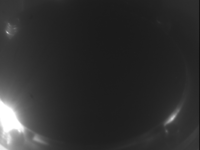 |
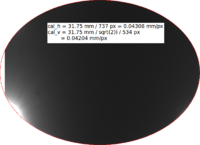 |
0.04308 | 0.04204 |
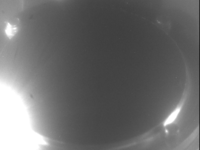 |
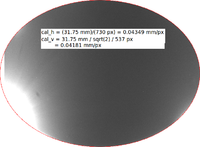 |
0.04320 | 0.04228 |
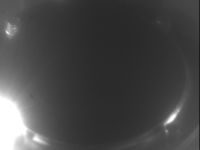 |
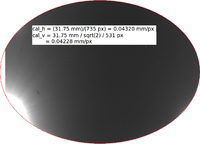 |
0.04349 | 0.04181 |
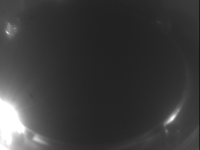 |
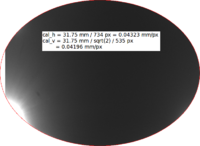 |
0.04323 | 0.04196 |
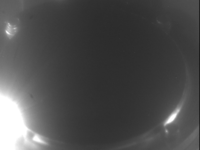 |
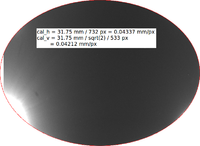 |
0.04337 | 0.04212 |
| mean (mm/px) | mean (mm/px) | ||
Non-Gaussian Fit for Beam
The projection of the beam is not Gaussian distribution. So, we fit Super Gaussian fitting <ref name="BeamDisBeyondRMS"> F.-J Decker, “Beam Distributions Beyond RMS”, BIW94, Vancouver,CA,Sep 1994, . </ref>.
<ref name="BeamDisBeyondRMS"></ref>
Parabola Fitting for the Sigmas
We used the MATLAB to analyze the data. The results shows that:
Positron Detection
To detect positrons created, we want a put Tungsten target at the end of 90 degree beamline. When positrons hit W-target, 511 keV photons will be created. We want to use NaI detectors to detect these 511 keV photons, so we might have an estimate on the numbers of the positrons we collect at the end of the 90 degree beamline.
We acquired some NaI crystals from Idaho Accelerator Center (IAC). We built our own PMT bases for them, since the bases we had not working properly. We modified the design of model PA-14 from Saint-Gobain crystals & detectors ltd. Following image is the design.
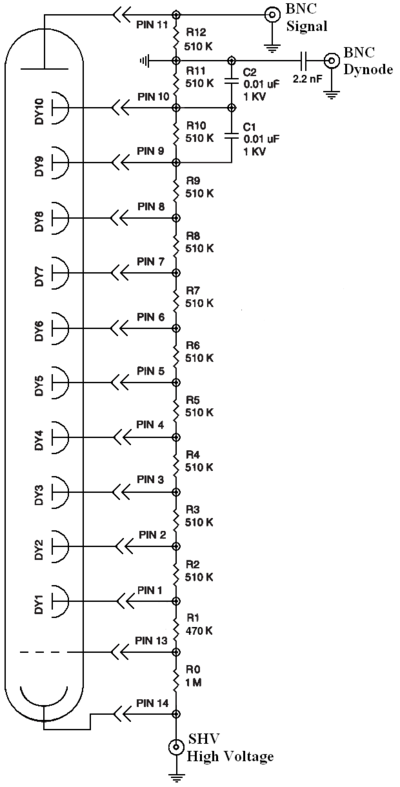 |
Future Plan
Positron Target
A tungsten target will be placed in the space between 1st and 2nd triplet. The tungsten target will be placed inside a big chamber.
We are going to run
Emittance tests with Energy Scan
We will do emittance test with precise energy scan. We remapped dipole magnet for more precise energy scan. This will also improve our emittance measurement.
Positron Yield
We will insert the first tungsten target and create positrons. We are expecting to collect part these positrons and transport them down the second tungsten target at the end of the 90 degree beamline. By doing these, 511 keV photons will be created and we want to detect them by our NaI detectors.
References
<references/>
